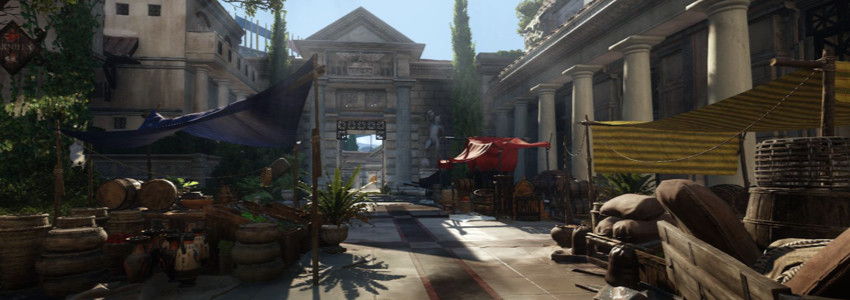Environments and Cinematics
In general, the lighting work in games can be broken down into two main camps: The Environment Lighting and the Cinematic Lighting. At many studios, the lighting artists work on both, but with specialization increasing, it's not unusual for larger studios to hire both environment lighters and cinematic lighters.
Environment Lighting:
The Environment Lighting Artist is responsible for the world lighting that the players will encounter as they make their way through the game. They'll be involved in everything from the time of day, to the atmospheric effects in different areas, the player path lighting (what the player sees as they make their way through the game) , and making sure the animated characters are lit to feel like they match the world they're in. You are lighting the world, and making sure it is believable. And looks cool.
The Player Path
Note that I mentioned above the player "path". While there are still many games that lead the player through the world based on a path or story line, there's also the "Open World" type of game, where there is no path. In that case the lighting needs to be something that just works everywhere, as there's a lot less that can be done to lead the player through a given area.
What I mean by that, is that if you have a game that is not open world, and the player follows a given path through the game, we know which direction the player is going, and we make lighting decisions based on that. The player spawns at a given point, then makes their way through the level until they reach the end. So for the lighting you would make sure that the sun is at an interesting angle and casting nice shadows along the surfaces the player comes across.

Environment Lighting: Colosseum level from Crytek's "Ryse: Son of Rome".
In fact, one of the first steps when you start to light a level that has a more linear progression is to decide on where the sun is, and the direction of shadows. Once that decision is made, and it's approved, that sun direction probably won't change unless a major change is made to the environment itself.
Note that this only applies to a level with static lighting, if you have a dynamic sun and time of day is always changing, things get trickier. Now you have to take into account the path of the sun and examine the level at different times of the day, to see which angles work best at different times.
Cinematic Lighting:
The Cinematic Lighting Artist is responsible for lighting the cinematics, also sometimes called "cutscenes". Some players love cinematics and feel that they really add to the story. Others don't care about the story, and just want to get back to shooting things again, and skip the cinematics entirely. It's important to understand that much of your work will never be seen by some people. (Haha! Just kidding! Sort of.)
(The word "cutscene" is an odd one, as it implies in film anyway, that the scene has been cut, as in "on the cutting room floor". But somehow it came to be used in games as another term for a cinematic. Probably because we're "cutting" from gameplay to cinematic, then back to gameplay.)
If a project has different people doing both types of lighting, it's important that there's good communication between the two teams. Frequently a cinematic lighting artist will want to add something to a scene to provide a more interesting lighting source for instance, and needs to figure out (by talking with the environment lighter) whether that's an element that can exist and stay in the environment. (For the sake of continuity, you don't want light sources suddenly popping off at the end of a cinematic when you return to the game, for example.)
Cinematic lighting usually involves the characters specifically, and is in part conveying a story line or event.

Cinematic Lighting: Fireteam Osiris members Vale, Locke, Buck, and Tanaka, from 343 Industries "Halo 5: Guardians".
The best situation is where the game cuts to a cinematic without any glaring differences, the cinematic plays out, then the player is returned to the game, all in a smooth transition that feels natural.

